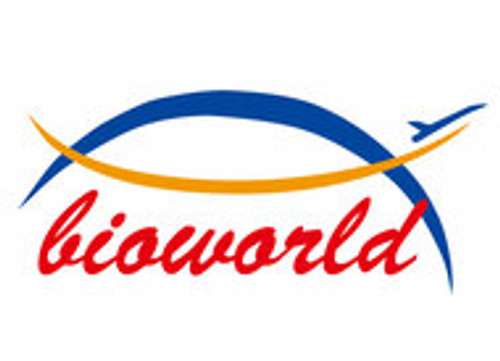Product Description
EPHB1/EPHB2/EPHB3 polyclonal antibody is available at gentaur for next week delivery
Background: The Eph receptors are the largest known family of receptor tyrosine kinases (RTKs). They can be divided into two groups based on sequence similarity and on their preference for a subset of ligands: EphA receptors bind to a glycosylphosphatidylinositol-anchored ephrin A ligand; EphB receptors bind to ephrin B proteins that have a transmembrane and cytoplasmic domain. Research studies have shown that Eph receptors and ligands may be involved in many diseases including cancer. Both ephrin A and B ligands have dual functions. As RTK ligands, ephrins stimulate the kinase activity of Eph receptors and activate signaling pathways in receptor-expressing cells. The ephrin extracellular domain is sufficient for this function as long as it is clustered. The second function of ephrins has been described as "reverse signaling", whereby the cytoplasmic domain becomes tyrosine phosphorylated, allowing interactions with other proteins that may activate signaling pathways in the ligand-expressing cells. Various stimuli can induce tyrosine phosphorylation of ephrin B, including binding to EphB receptors, activation of Src kinase, and stimulation by PDGF and FGF. Tyr324 and Tyr327 have been identified as major phosphorylation sites of ephrin B1 in vivo. EphB1 is a member of the Eph family of receptor tyrosine kinases that plays an important role in diverse biological processes including nervous system development, angiogenesis, and neural synapsis formation and maturation. Over- or underexpression of certain Eph receptors has been found in some cancer tissues. EphB1 has been shown to be involved in the tumorigenesis of colorectal cancer.The ephrin receptor B2 (EphB2) is an ephrin family receptor tyrosine kinase that plays an important role in regulating growth and development of multiple tissues and organs. The EphB2 transmembrane receptor protein contains a kinase domain, a PDZ motif, and a SAM domain within a conserved cytoplasmic domain. A ligand binding domain, a cysteine-rich domain, and fibronectin type III repeats comprise the conserved EphB2 extracellular domain. EphB2 binds with high affinity to ephrin B ligands, and to some ephrin A proteins, to initiate bidirectional signaling between neighboring cells. Upon binding, EphB2-Ephrin B2 dimers form a heterotetramer and position the receptor-ligand complex on the cell membrane to facilitate bidirectional signal transduction. In addition to associating with ephrin ligands, EphB2 also regulates a number of biological processes through interaction with focal adhesion kinase (FAK), NMDA receptor (NMDAR), the Rac1 guanine nucleotide exchange factor Tiam1, and p21-activated kinase (PAK1). While some studies support a role for EphB2 as a pro-oncogenic kinase, other research suggests that EphB2 acts as a tumor suppressor.
Applications: WB
Purification&Purity: The antibody was affinity-purified from rabbit antiserum by affinity-chromatography using epitope-specific immunogen and the purity is > 95% (by SDS-PAGE).
Storage&Stability: Store at 4°C short term. Aliquot and store at -20°C long term. Avoid freeze-thaw cycles.
Specificity: EPHB1/EPHB2/EPHB3 polyclonal antibody detects endogenous levels of EPHB1/EPHB2/EPHB3 protein.
W4BiowMW: ~ 130 kDa
Reactivity: Human,Rat,Mouse
Note: For research use only, not for use in diagnostic procedure.
Immunogen:
Synthetic peptide, corresponding to Human EPHB1/EPHB2/EPHB3.Alternative Name:
Ephrin type-B receptor 1; ELK; EPH tyrosine kinase 2; EPH-like kinase 6; EK6; hEK6; Neuronally-expressed EPH-related tyrosine kinase; NET; Tyrosine-protein kinase receptor EPH-2; EPHB1; EPHT2; HEK6; Ephrin type-B receptor 2; Developmentally-regulated Eph-related tyrosine kinase; ELK-related tyrosine kinase; EPH tyrosine kinase 3EPH-like kinase 5; EK5; hEK5; Renal carcinoma antigen NY-REN-47; Tyrosine-protein kinase TYRO5; Tyrosine-protein kinase receptor EPH-3; EphB2/CTF1; EphB2/CTF2; EPHB2; DRT; EPHT3; EPTH3; ERK; HEK5; TYRO5; Ephrin type-B receptor 3; EPH-like tyrosine kinase 2; EPH-like kinase 2; Embryonic kinase 2; EK2; hEK2; Tyrosine-protein kinase TYRO6; EPHB3; ETK2; HEK2; TYRO6Western blot analysis: Western blot (WB) analysis of EPHB1/EPHB2/EPHB3 polyclonal antibody at 1:500 dilution Lane1:A549 whole cell lysate(30ug) Lane2:HEK293T whole cell lysate(40ug) Lane3:The Heart tissue lysate of Rat(30ug) Lane4:The Brain tissue lysate of Mouse(40ug)
Immunohistochemistry:
Immunofluorescence analysis:
Host: Rabbit
Swiss-Prot: P54762/P29323/P54753
"








